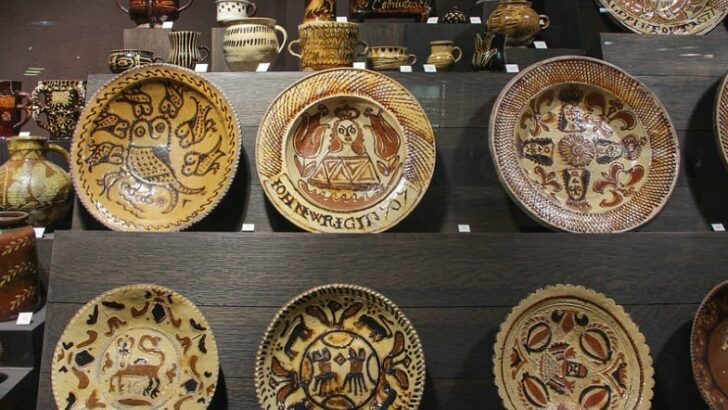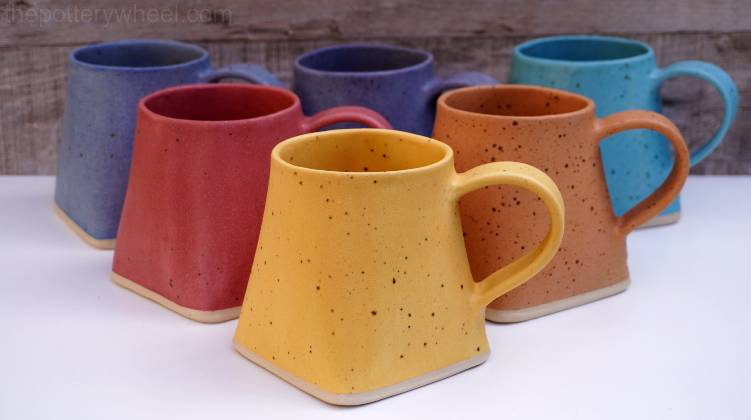Slipware is a form of ceramics that involves decorating lead-glazed earthenware. Primarily, slip is a liquid form of clay particles suspended in water. That is the simplest form. In its sophisticated form, slip features feldspars, colorants, frits, and fluxes. Usually, slip is in a bright color that bears great contrast to the body of the underlying vessel.
Slipware has been around for centuries, as the use of slip can be dated back to hundreds of years ago. It has a large bearing in England, more so the Staffordshire region. For this reason, slipware is often viewed as a staple product of English potters. Read on to learn more about its origins, how it is made and how valuable it is in today’s world.
Where Did Slipware Originate?
The use of slip as a decorative method is believed to have originated in Asia, more specifically, the Far East. Fragments of slipware, red-slipped pottery; that age approximately 5000 years have been discovered in Japan.
Fragments have also been found in other locations in Europe. For instance, white slip decoration that dates back to 2000 B.C has been spotted on the island of Crete.
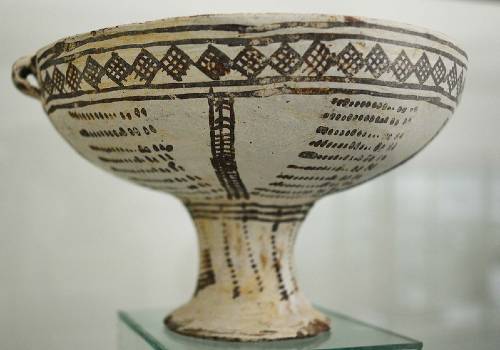
(CC BY-NC-ND 2.0)
The Chinese also practiced slipware pottery, particularly popular during the Song Dynasty (960-1279) (source). The potters painted their vessels using a unique feather slip technique. They continued to advance in their skill to a point where they could make incised marbleized patterns through white slip washes.
The use of slip continued to spread across Europe in the middle ages. Italians, the Spanish, and Germans picked up the art in the 15th Century. In the mid-1600s, the use of slip spread across England, where its technique reached a new level of technique, skill, and excellence.
English slipware potters exhibited expertise that had never been experienced before. They bring out a certain cheerful character along with profound imagination and character in their brown and yellowing lead glazes.
How Is Slipware Made?
Essentially, slipware is pottery that has been treated with semi-liquid clay. It involves dipping a vessel in pale slip, then decorating it with various slip colors in intricate patterns.
Slip can be applied to the whole vessel or part of it to enhance its appearance, smoothen it, or for decorative effect. It is applied through several techniques such as painting, piping in much the same way we put icing on a cake or scratching the slip off.
As such, different methods of making slipware include the sgraffito technique, marbling, and combing.
Sgraffito Method:
This slip technique originated from Italy in the 15th Century, before other European countries picked it up. Sgraffito involves coating vessels or hard leather plates with slip, then scratching it off with a sharp tool to come up with decorative designs.
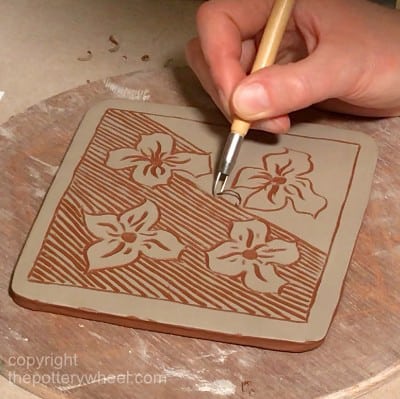
The process of sgraffito is usually done when the vessel is still unfired. For plates, this is often done on their face and outside for other vessels. This method of making slipware is most preferred when the base vessel does not have the desired color or texture.
The Marbling Method:
This method of making slipware involves applying multiple slip lines of different colors on a base body. The application is made using a slip cup that has multiple tubes.
The potter rotates, tilts, and wiggles the vessel during the process so that centrifugal force and gravity move the slip lines into a marbleized pattern. This technique requires a high level of expertise on the potter’s part because a small mistake can mess up the whole process.
Slipware Combing:
Also known as feathering, this method is quite similar to marbling. It involves trailing colored slips on a contrasting slip ground, then drawing a pointed object along the lines to create a complex pattern of troughs and peaks. This method of creating slipware was largely used in Staffordshire, England.
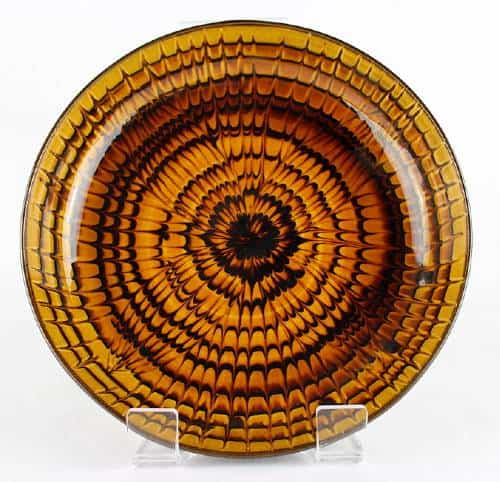
Also referred to as barbotine by the French, slip has a short working time. It solidifies very fast when it comes in contact with a hard surface. For this reason, if you make any mistake while making slipware, you would have to start from scratch as it would be nigh impossible to make a timely correction. Thus, you have to stir the slip constantly to keep it in suspension and in good working condition.
17th Century English Slipware Pottery
17th century England was the greatest ceramic period where slipware pottery is concerned. The period is marked by talented potters that raised the standards of slipware pottery all over the world.
The most famous slipware potter of this era was Thomas Toft, who hailed from Staffordshire. He is known to have practiced pottery between 1660 and 1680. Other great potters attributed to this period include Ralph Simpson, Thomas Simpson, Ralph Turnor, Richard Meir, and William Talor.

Before 1760, most English slip decoration was done by hand, so the potter’s skill and ability determined how the art would turn out.
However, this technique was soon replaced by the use of a lathe, which was more efficient and less demanding skill-wise. The lathe was marked by a fixed horizontal movement of the vessel that enabled the application of uniform slip in a straight line.
Slipware in 17th Century England was mostly produced in the regions of Staffordshire and Wrotham. Some of the ornaments made would include plates, cups, jugs, and candlesticks.
Staffordshire Slipware
Most of the slipware ceramics of 17th Century England were created in Staffordshire. This region favored slipware pottery for various reasons. These reasons are:
- There was the ready availability of different types of clay and a source of lead ore.
- Potters could access fuel from nearby woodlands.
- The river Trent was a reliable source of transport, and the main ports were conveniently close.
Thomas Toft, who is arguably the most important slipware potter of 17th Century England, hailed from Staffordshire. There are about thirty of his pieces kept in art galleries and museums today.
He is famous for his elaborately deco-ornamental dishes, which were solely for display purposes. The themes that Toft used in his craft include crests, figures of royalty, coats-of-arms, and other emblems.
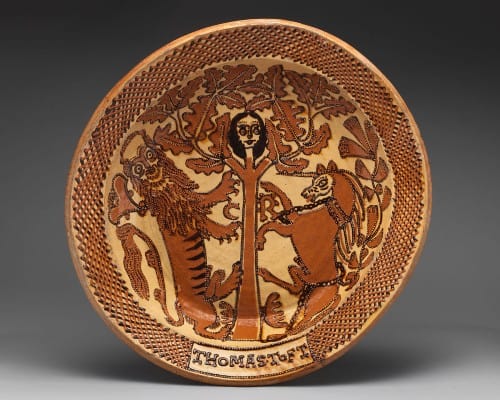
Toft’s style was echoed by other slipware potters of the time like his brother, Ralph. His sons James and Tomas Toft also borrowed his artistic aura.
It can be said that Toft paved the way for other designers, including contemporary slipware potters such as William Taylor and Ralph Simpson.
How to Identify Slipware Pottery
Slipware pottery can be identified by its decoration style, which is distinct from other types of pottery. Slipware pottery is decorated by placing slip onto the aqueous clay base-body and firing it by painting, dipping, or splashing.
Most slipware ornaments from the earlier centuries also have inscriptions that are synonymous with that kind of pottery. Different potters had signature inscription methods to identify their work. For instance, it is easy to tell apart Thomas Loft’s pottery from, say, William Taylor’s.
Is Slipware Valuable?
Slipware is valuable, especially in communities where it is part of the heritage and culture, such as European countries. England, for one, has a very rich history in slipware ceramics.
Not only does the pottery represent the artistic prowess of the English people, but slipware also used to be a way for people in the community to come together and bond. The pieces tell stories of births, marriages, deaths, politics, and even the coronation of kings and queens.
Today, slipware pieces are kept in select galleries around the world. They are valued at about $200 t0 $13,700, depending on their different qualities. On average, an ornament will cost $1 239.
Final Thoughts
Slipware pottery has been around for thousands of years. It is believed to have originated from Asia as 5000-year-old red-slip fragments have been discovered in the Far East. Similarly, 2000-year-old white-slip fragments have also been discovered in the Island of Crete, Greece. Thus, the use of slipware was originally tied to some parts of Europe and Asia before it spread.
By the Middle Ages, slipware pottery was pretty popular in most of Europe. In the 17th Century, England became a hallmark of slipware pottery, with talented potters such as Thomas Loft of Staffordshire creating masterpieces.
Featured Image Credit
Featured image by KotomiCreations, “The Potteries Museum & Art Gallery – Stoke-on-Trent“, (CC BY-NC 2.0)

